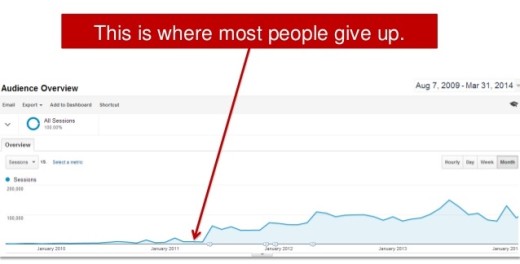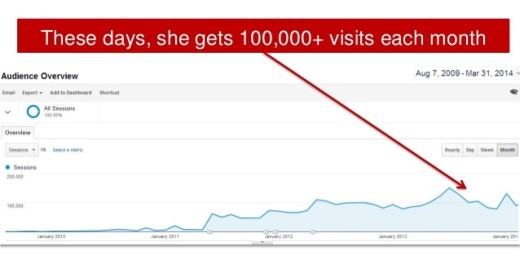
Building a successful blog is hard. There’s a lot more to it than simply creating a blog and writing your first post. For starters, readers won’t show up just because you’re writing. You have to tell people about your work if you want them to care.
But a lot of what it takes to build a successful blog is just being good at showing up. Over and over. For a long, long time.
When asked how he built such a robust online community with his blog, Jon Acuff’s answer was simple: “The same way you build an offline one. Slowly and honestly.” — Jeff Goins
Most people give up too early
When you write your first post and nobody reads it, it’s pretty disappointing. When you write your twelfth post and nobody reads it, that’s tough. But what about when you’ve been blogging consistently for six months, or a year, and still hardly anyone is taking notice?
The truth is, that’s not uncommon. It takes a long time for an audience to grow. And it can be incredibly demoralising to keep showing up when nobody else seems to care.
So it’s no surprise that most people give up on their blogs too early.
One of my favourite examples of not giving up is the story Rand Fishkin tells about his wife, Geraldine, and her travel blog, Everywhereist. When Rand tells the story of how Everywhereist grew, he uses it as a cautionary tale. Unlike the common thinking that if you write great content people will read it and share it and your traffic will start growing immediately, this is a story of a much more likely journey to success.

About two years in, Geraldine had some small spikes of traffic from a couple of posts that got noticed more than usual. They probably looked like enormous spikes at the time, but you can see on these graphs how small they are in hindsight.

Everywhereist traffic went back to what it had been before those spikes and stayed there for a while. As Rand says, most people would give up at that point.

But Geraldine stuck at it, and five years on she’s getting six figures of traffic every month.
As author and blogger Reggie Solomon says, “We may all wish for a silver bullet to bolster readership, but it’s less a case of scoring a home run and more a case of getting singles on the board.”
What success really takes
It’s easy to respect people like Geraldine who stick it out and build successful blogs without fully understanding the hard slog they went through. Most of the time we don’t even have graphs like the ones above to give us a more realistic picture of the journey it takes to become successful.
We’re left with quotes or snippets from interviews and our brains fill in the gaps for us. Usually those gaps are filled with things like “they had it easy from the start”, or “that could never happen to me”, or “they must know famous people who helped them to be successful”.

I think people believe that those who show up consistently have some sort of magic power or inherent ability. “It must come easy for him,” they say. “For others like me, it’s hard.”
Here’s the reality: it’s not easy for anyone—even the people that make it look easy. In fact, if someone is making it look easy, they’re probably working all the harder. — Sean McCabe
It’s incredibly rare to get a fluke that makes you popular immediately, and even more rare for that success to continue over time. Look at Geraldine’s graphs—even when people finally started paying attention to her work after two years, it didn’t last. Her traffic dropped back to what it had been right after that.
Betting on a fluke is unpredictable, and if you’re building a blog for your business, it’s—frankly—irresponsible. Just because you can’t control every aspect of how successful your blog becomes doesn’t mean you should leave it entirely to chance.
Don’t bet your marketing on being the 1 in 1,000 — Rand Fishkin
The best bet you can make on your blog is to work on it every day for years. It’s hard, and it’s frustrating, and it requires a lot of discipline (or a lot of love for the work you’re doing), but it’s the most reliable approach to building a successful blog. Not a surefire approach, unfortunately, but the most reliable.
The people that show up every day do it because it’s a thing that they do… That doesn’t mean it’s always easy to show up, but it does mean there’s no question of whether they’re going to show up. — Sean McCabe
Setting yourself up for success
This stuff is hard. I’m not pretending it’s easy, and you shouldn’t either. We’re much better off admitting it’s hard and committing to doing it anyway.
And don’t get down on yourself for wanting to quit. We all feel that struggle, and we all have to push through it to make the effort to show up every day.
These are the best ways I’ve discovered to set myself up for a long, hard slog. Mostly it’s about preparing yourself for the inevitability that it’s going to get hard and you’ll need to keep going anyway.
1. Choose something you enjoy the process of
If you’re blogging for rewards alone, two years is a long time to wait for results. And you might need even longer to find success.

It’s a lot easier to keep at something without seeing a return if you really enjoy it. If you’re creating your own blog, you have free-reign to choose whatever you want to focus on so pick something you like. If you’re creating content for your company, look for ways to write content you relate to—whether that’s finding different angles on your focus topic, going deeper on the particular aspects that interest you most, or exploring different content formats.
For Lindsay and Bjork, the creators of food blog Pinch of Yum, the first couple of years were all about trying and sharing new recipes. Lindsay says they didn’t even consider monetising their blog initially.
I’m really thankful for this because those first few years were really fun and I think if I would have been expecting to get lots of money from the blog, it would have been full of disappointments. It takes a long time to build a blog and I’m just thankful that my first few years were purely for fun!
This doesn’t mean it’s wrong to build your blog with the aim of making money, but choosing something you’re happy to do for the first two years just for fun will help you stick it out while your audience grows.
Building a blog is a gradual thing that takes TIME – it’s not an overnight thing and it doesn’t come without putting in many hours of focused work. If you enjoy it and it doesn’t feel like work, you’ll be able to do more and stick with it which will eventually lead to growth.
Author Pamela Slim agrees with this idea:
It took about a year to develop a steady group of readers. It was very slow at first, but I found great joy in writing so I kept producing posts.
And don’t be afraid to experiment. It might take you a few weeks to realise youdon’t enjoy the process of creating content that you thought you would. If you know you don’t want to do it for the next 2-3 years, just a few weeks in is a good time to rethink what you’re writing about.
2. Set a schedule
Having a schedule does something very powerful for your blog. It makes showing up to write just a thing you do. It’s no longer something you find time for, or something you do when you feel like it. You publish content on time, as your schedule dictates, because that’s what you do.
Until something is just a “thing that you do” there will continue to be the option of not doing it. — Sean McCabe
The obvious caveat here is that you need to stick to your schedule for it to work. Which means you need to choose a schedule that’s manageable. If you struggle to write one post a week, start with a schedule of just one post every two weeks.
The next step is to start building up a buffer of content so you don’t have to drop your schedule when you’re running behind or if you get sick.
Another great part of having a schedule is how you can watch your archives grow as you create content on a regular basis. Just publishing once a week will give you twelve posts after three months, 24 after six months, and 52 in a year. If you’re writing around 1,000 words per post, you’ve easily written a book in just a year!
And that’s just one post per week.
3. See it as a process
Franklin Leonard was a film executive when he created The Black List. He asked his friends in the film industry to recommend their favourite unproduced scripts via email for some holiday reading. His email request was shared throughout the industry and Leonard received around 500 responses.
That email was the catalyst for what eventually became The Black List—a site where writers can submit their scripts in the hopes of being discovered by film executives. Through The Black List, previously overlooked films such as Argo,Juno, and The King’s Speech have gone on to production.
Leonard says his site is helping writers get feedback, improve their work, and for some, have their work produced. But he doesn’t look at scripts going into production as the final moment of “success”:
Success is usually not one moment. It is a series of minor successes. It is getting feedback for the first time. It is completing a rewrite based on that feedback. It is discovering that your rewrite did, in fact, improve your script. It is doing another rewrite. It is having a bunch of people read your script because it attracted attention. It is an agent calling you for the first time. It is signing with an agent. It is being referred to a production company or studio. There are many successes on the way to what most people would perceive as public success. And I know for me, the only way that I have been able to continue to wake up every morning is by trying to focus on those immediate successes and acknowledging them for what they are.
When you’re working hard every day to build a successful blog, it’s easy to overlook the little steps of success that happen along the way. Perhaps in Geraldine’s case, those small bumps in traffic that came after two years were enough to inspire her to keep going when traffic dropped again.
Whatever small wins you collect along the way, count those as success. As Leonard says, focusing on the immediate successes can be what you need to keep going.
I’m one of those people who thinks they’re not afraid of hard work until I actually have to do it. That’s usually when I decide I don’t mind doing hard work, just notthis particular hard work. I want to try something else now.
Don’t be like me. Prepare yourself for a long, long journey with your blog and see it through. When everyone else (like me) is giving up, you’ll be the one telling your story with graphs like Geraldine’s and cautioning new bloggers not to give up too early.
Read Next: How to syndicate your content
Image credit: Shutterstock, Show up every day via seanwes. Endurance via seanwes. Everywhereist graphs via Rand Fishkin.
This post first appeared on Ghost.
Get the TNW newsletter
Get the most important tech news in your inbox each week.




